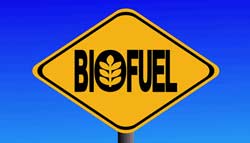New Method Turns Biomass Waste Into Fuel

Scientists, including those of Indian-origin, have developed a new method that can turn biomass waste into chemical products which can be used to create high-octane fuel for jets and race cars.
A team of researchers from Purdue University's Center for Direct Catalytic Conversion of Biomass to Biofuels, or C3Bio, has developed a process that uses a chemical catalyst and heat to spur reactions that convert lignin into valuable chemical commodities.
Lignin is a tough and highly complex molecule that gives the plant cell wall its rigid structure.
"We are able to take lignin - which most biorefineries consider waste to be burned for its heat - and turn it into high-value molecules that have applications in fragrance, flavouring and high-octane jet fuels," said Mahdi Abu-Omar, Professor of Chemical Engineering and associate director of C3Bio, who led the team.
"We can do this while simultaneously producing from the biomass lignin-free cellulose, which is the basis of ethanol and other liquid fuels. We do all of this in a one-step process," he said.
The Purdue team developed a process that starts with untreated chipped and milled wood from sustainable poplar, eucalyptus or birch trees.
A catalyst is added to initiate and speed the desired chemical reactions, but is not consumed by them and can be recycled and used again. A solvent is added to the mix to help dissolve and loosen up the materials.
The mixture is contained in a pressurised reactor and heated for several hours. The process breaks up the lignin molecules and results in lignin-free cellulose and a liquid stream that contains two additional chemical products, Abu-Omar said.
The liquid stream contains the solvent, which is easily evaporated and recycled, and two phenols, a class of aromatic hydrocarbon compounds used in perfumes and flavourings.
A commonly used artificial vanilla flavouring is currently produced using a phenol that comes from petroleum, Abu-Omar said.
The team also developed an additional process that uses another catalyst to convert the two phenol products into high-octane hydrocarbon fuel suitable for use as drop-in gasoline.
The fuel produced has a research octane rating greater than 100, whereas the average gas we put into our cars has an octane rating in the eighties, Abu-Omar said.
In addition to Abu-Omar, co-authors include chemical engineering graduate student Harshavardhan Choudhari, Basudeb Saha, associate research scientist in chemistry, and Rakesh Agrawal, the Winthrop E Stone Distinguished Professor of Chemical Engineering.
The process is described in a paper published in the Royal Society of Chemistry journal Green Chemistry.
Trending News
 3 mins readWill The Kawasaki W230 Be Launched In India?
3 mins readWill The Kawasaki W230 Be Launched In India?
Latest News
 Jafar Rizvi | Dec 27, 2025Listed: Car Manufacturers That Will Hike Prices From January 2026Based on the announcements made so far, the price increase across car models is expected to range between 2 and 3 per cent.3 mins read
Jafar Rizvi | Dec 27, 2025Listed: Car Manufacturers That Will Hike Prices From January 2026Based on the announcements made so far, the price increase across car models is expected to range between 2 and 3 per cent.3 mins read Jaiveer Mehra | Dec 26, 2025India-Spec New Renault Duster Teased Ahead Of Jan 26 DebutA new teaser video provides brief glimpses of the upcoming all-new SUV which seems to get some notable styling differences over its global sibling.1 min read
Jaiveer Mehra | Dec 26, 2025India-Spec New Renault Duster Teased Ahead Of Jan 26 DebutA new teaser video provides brief glimpses of the upcoming all-new SUV which seems to get some notable styling differences over its global sibling.1 min read Jaiveer Mehra | Dec 26, 2025New Mahindra XUV 7XO Teaser Confirms 540 Degree CamerasLatest teaser video confirms the SUV will get the new 540 degree camera set-up from the XEV series as well as a few other features.1 min read
Jaiveer Mehra | Dec 26, 2025New Mahindra XUV 7XO Teaser Confirms 540 Degree CamerasLatest teaser video confirms the SUV will get the new 540 degree camera set-up from the XEV series as well as a few other features.1 min read car&bike Team | Dec 24, 2025Updated Bajaj Pulsar 150 Launched At Rs 1.09 Lakh: Gets LED Lighting, New ColoursThe Pulsar 150 is offered in three variants with prices topping out at Rs 1.15 lakh (ex-showroom).2 mins read
car&bike Team | Dec 24, 2025Updated Bajaj Pulsar 150 Launched At Rs 1.09 Lakh: Gets LED Lighting, New ColoursThe Pulsar 150 is offered in three variants with prices topping out at Rs 1.15 lakh (ex-showroom).2 mins read Janak Sorap | Dec 24, 20252026 Kawasaki Ninja 650 Launched at Rs 7.91 LakhWith E20 compliance, the 2026 Ninja 650 receive a new colour update and a premium price tag.1 min read
Janak Sorap | Dec 24, 20252026 Kawasaki Ninja 650 Launched at Rs 7.91 LakhWith E20 compliance, the 2026 Ninja 650 receive a new colour update and a premium price tag.1 min read car&bike Team | Dec 24, 2025KTM RC 390 Discontinued Globally, Remains On Sale In IndiaThe KTM RC 390 will continue to be offered on sale in India, where it is manufactured and there’s still strong demand for the model.2 mins read
car&bike Team | Dec 24, 2025KTM RC 390 Discontinued Globally, Remains On Sale In IndiaThe KTM RC 390 will continue to be offered on sale in India, where it is manufactured and there’s still strong demand for the model.2 mins read
 Jafar Rizvi | Dec 24, 2025MG Windsor EV 38 kWh Long-Term Report: IntroductionThe Windsor EV has joined our garage, and before it settles into daily duty, I took it out to get a sense of what living with an electric car is like.4 mins read
Jafar Rizvi | Dec 24, 2025MG Windsor EV 38 kWh Long-Term Report: IntroductionThe Windsor EV has joined our garage, and before it settles into daily duty, I took it out to get a sense of what living with an electric car is like.4 mins read Seshan Vijayraghvan | Dec 23, 20252026 Kia Seltos Review: Formula Is Spot On, But Is The Timing Right?The 2nd-gen Kia Seltos has arrived, but it has the challenge of facing strong rivals like the Victoris and Sierra. The question is simple - Does it still have what it takes?9 mins read
Seshan Vijayraghvan | Dec 23, 20252026 Kia Seltos Review: Formula Is Spot On, But Is The Timing Right?The 2nd-gen Kia Seltos has arrived, but it has the challenge of facing strong rivals like the Victoris and Sierra. The question is simple - Does it still have what it takes?9 mins read car&bike Team | Dec 26, 2025Tata Punch EV Long-Term Second Report: Highway Performance, Pros & ConsAfter a week of living with the Tata Punch EV Long Range—including a proper Mumbai-Nashik highway test—we've learned what this little electric SUV is really made of.1 min read
car&bike Team | Dec 26, 2025Tata Punch EV Long-Term Second Report: Highway Performance, Pros & ConsAfter a week of living with the Tata Punch EV Long Range—including a proper Mumbai-Nashik highway test—we've learned what this little electric SUV is really made of.1 min read Seshan Vijayraghvan | Dec 22, 20252026 Tata Harrier & Safari 1.5 Hyperion Review: By The Power Of Petrol!The new Tata Harrier and Safari petrol packs a new 1.5-litre TGDI Hyperion engine, but is it an ideal alternative to the diesel version?7 mins read
Seshan Vijayraghvan | Dec 22, 20252026 Tata Harrier & Safari 1.5 Hyperion Review: By The Power Of Petrol!The new Tata Harrier and Safari petrol packs a new 1.5-litre TGDI Hyperion engine, but is it an ideal alternative to the diesel version?7 mins read Bilal Firfiray | Dec 19, 2025Maruti Suzuki e-Vitara Review: Worth The Wait?After a long wait, the first-ever electric Maruti Suzuki is here. It’s the e-Vitara, and it comes with a few promises. But arriving this late, is it worth the wait? Or is it a case of too little, too late?9 mins read
Bilal Firfiray | Dec 19, 2025Maruti Suzuki e-Vitara Review: Worth The Wait?After a long wait, the first-ever electric Maruti Suzuki is here. It’s the e-Vitara, and it comes with a few promises. But arriving this late, is it worth the wait? Or is it a case of too little, too late?9 mins read































































































































